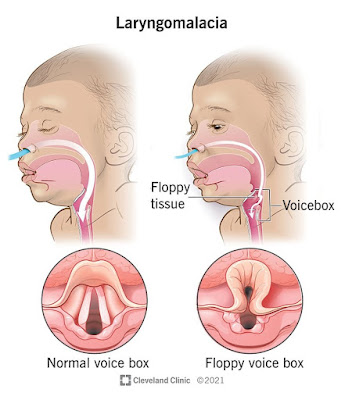Laryngomalacia
Stridor is the sound produced when an infant breathes through a narrowed upper airway.
Laryngomalacia is the most
common cause of Stridor in new-borns and is the cause in more than half of those
with congenital stridor.
The stridor is explained by Bernoulli's principle,
which states that as the speed of a moving fluid increases, the pressure
within the fluid decreases. When airflow is forced through a narrowed tube,
a local area of low pressure creates a vacuum effect distal to the narrowing-
This causes the high-pitched sound of the stridor.
The sound can be a source of great worry for the
parents since in severe stridor the child sometimes struggles to breathe.
It is heartening to note that most children with
laryngomalacia will improve by 1-2 years of age without any significant
morbidity.
Some may have troubling and sometimes life threatening laryngomalacia and this require special treatment.
 Why does Laryngomalacia occur?
Why does Laryngomalacia occur?
Though there are many theories, currently the “Neurologic Theory” is generally accepted. The neural responses from the larynx of the child are not well formed – this results in the stridor as well as the associated feeding difficulties. As the child grows up the nervous system matures and the breathing becomes better – by about 12 to 24 months of age. The previously held "Cartilaginous Theory" - that the cartilages of the larynx/ upper airway are weak and pliant and get sucked in during the negative pressure of inspiration has been refuted.
PRESENTATION AND DISEASE SEVERITY
Laryngomalacia typically causes stridor in
children at birth or soon after.
The stridor increases over a few months and
then begins to resolve by 12 to 24 months of age.
Symptoms
- Inspiratory Stridor
- Feeding difficulty- lack of
coordination in the suck-breathe
- Cough
- Regurgitation of food In severe cases
- Poor weight gain
- Increased respiratory rate, indrawing
of chest and sleep apnoea
Disease Severity
1. Mild – simple stridor which disappears over
time
2. Moderate – stridor along with feeding
difficulties and occasional aspiration
3. Severe – Stridor along with episodes of
Cyanosis (turning blue), chest indrawing, SPO2 of less than 90%, feeding
problems and failure to thrive.
DIAGNOSIS
This is usually made by doing a Flexible Laryngoscpic examination
– collapse of the supraglottic tissue (tissue above the vocal cords) is the diagnostic finding. This is done in the awake child. There are other typical findings including
- prolapse of posteriorly placed arytenoid cartilages and mucosa into the airway during inspiration
- shortening of the distance between the Epiglottis and the Arytenoids
- 'Omega shaped' Epiglottis
MANAGEMENT
MILD CASES
Will resolve on their own. No special
treatment may be required – this is up to 40 % of children with Laryngomalacia.
MODERATE CASES
- Feeding assistance- thicken the formula, feed upright,
- Prevent Acid reflux- antacid
SEVERE CASES
- Treat for Acid Reflux
- Surgical Treatment –
o Supraglottopexy- where excess tissue is removed
o Tracheostomy – rarely – for life threatening stridor



Comments
Post a Comment